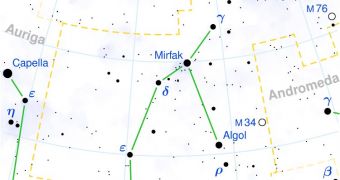Ancient Egyptians may have been conducting observations of the variable star Algol, also known as the Demon Star, thousands of years ago. A papyrus called Cairo 86637 suggests that a calendar based on the star's variations may have had a significant influence on society.
The conclusion belongs to a study entitled “Did the ancient egyptians record the period of the eclipsing binary Algol - the Raging one?” which was authored by astronomers at the University of Helsinki, in Finland. They explain that Algol is an eclipsing binary system.
This means that what is perceived from Earth as a variable star is in fact a system made up of two stars, where one of them passes in front of the other at regular intervals, causing a dip in the latter's brightness. From our vantage point, it appears is if the single star flickers.
As an interesting side note, the NASA Kepler Telescope has thus far identified 2,325 extrasolar planetary candidates using the same method. The only difference is that the observatory is looking for planets dimming light produced by their parent stars, not other stars.
Modern-day astronomers cannot fathom how their counterparts living three millennia ago were able to observe the binary system. The papyrus Cairo 86637 is now believed to the be oldest archaeological evidence that Egyptians were conducting this type of observations, EurekAlert reports.
“The texts regarding the prognoses are connected to mythological and astronomical events,” University of Helsinki Master of Science, Sebastian Porceddu, explains. He adds that the dimmer star in Algol dims the brighter one once every 2,867 days (7.8 years).
“These eclipses last about ten hours and they can be easily observed with bare eyes. Their period was discovered by Goodricke in the year 1783. We can explain why the period of Algol has increased by about 0.017 days,” University Docent Lauri Jetsu says.
“The period increase during the past three millennia could have been caused by the observed mass transfer between the two members of this binary. In fact, this would be the first observation that confirms the period increase of Algol and it also gives an estimate of the mass transfer rate,” he goes on to say.
What is even amazing is the fact that the ancient references are now very useful for modern astronomers, since they provide useful constraints. “It seems that the first observation of a variable star was made 3000 years earlier than was previously thought,” Jetsu concludes.

 14 DAY TRIAL //
14 DAY TRIAL //